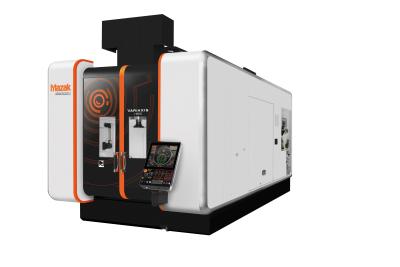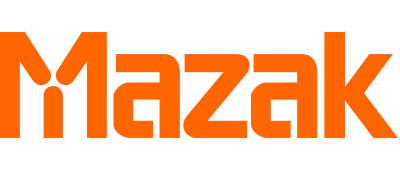
The versatile Variaxis i-800 machining center uses full, simultaneous 5-axis capabilities to perform multiple and complex curved-surface machining on large, heavy workpieces in single setups. The Variaxis i-800 reduces production lead times, improves machining accuracy and lowers operating expenses. Furthermore, it can tackle a wide range of applications, from heavy-duty cutting to high-speed cutting of aluminum and other nonferrous
materials.
Thanks to a Y-axis travel of 33.46” and X axis of 28.74”, the Variaxis i-800 accommodates workpieces measuring up to 39.37” in diameter (28.74” when equipped with a two-pallet changer) and 19.69” in height. With 360 degrees of rotation on the C axis and +30 degrees through -120 degrees of tilt on the A-axis, its roller gear cam-driven rotary/tilt table is supported at both ends for stability and high accuracy.
In its standard configuration, the Variaxis i-800 includes a high-rigidity 10,000-rpm, 50-hp, 50-taper spindle with a compact nose design that helps increase the machine’s Z-axis stroke to 22.05" and allows for the use of shorter tools to increase overall machining stability. An 18,000-rpm spindle is also available. With a standard 30-tool magazine capacity and optional configurations for up to a maximum of 120 tools, a reliable cam-driven toolchanger enables the Variaxis i-800 to meet the machining requirements of a wide variety of workpieces.
To increase speed and productivity, the machine's X, Y and Z axes feature 1,654-ipm rapid traverse rates and the Mazak MX Hybrid Roller Guide System, which delivers the level of durability and reliability needed for long-term accuracy. This innovative way system increases vibration damping, extends tool life, handles higher load capacities
and uses a greener grease-based lubrication system to eliminate tramp oil in the coolant.
Featuring Mazak’s Mazatrol SmoothX CNC, the Variaxis i-800 makes it easy to generate programs for processing complex parts through off-centerline machining, as well as angled drilling, milling and tapping with effortless programming in EIA/ISO or Mazatrol conversational language. The control incorporates a wide variety of advanced programming functions for ease of use and high-speed, high-accuracy machining performance.
Contact Details
Related Glossary Terms
- computer numerical control ( CNC)
computer numerical control ( CNC)
Microprocessor-based controller dedicated to a machine tool that permits the creation or modification of parts. Programmed numerical control activates the machine’s servos and spindle drives and controls the various machining operations. See DNC, direct numerical control; NC, numerical control.
- coolant
coolant
Fluid that reduces temperature buildup at the tool/workpiece interface during machining. Normally takes the form of a liquid such as soluble or chemical mixtures (semisynthetic, synthetic) but can be pressurized air or other gas. Because of water’s ability to absorb great quantities of heat, it is widely used as a coolant and vehicle for various cutting compounds, with the water-to-compound ratio varying with the machining task. See cutting fluid; semisynthetic cutting fluid; soluble-oil cutting fluid; synthetic cutting fluid.
- gang cutting ( milling)
gang cutting ( milling)
Machining with several cutters mounted on a single arbor, generally for simultaneous cutting.
- machining center
machining center
CNC machine tool capable of drilling, reaming, tapping, milling and boring. Normally comes with an automatic toolchanger. See automatic toolchanger.
- milling
milling
Machining operation in which metal or other material is removed by applying power to a rotating cutter. In vertical milling, the cutting tool is mounted vertically on the spindle. In horizontal milling, the cutting tool is mounted horizontally, either directly on the spindle or on an arbor. Horizontal milling is further broken down into conventional milling, where the cutter rotates opposite the direction of feed, or “up” into the workpiece; and climb milling, where the cutter rotates in the direction of feed, or “down” into the workpiece. Milling operations include plane or surface milling, endmilling, facemilling, angle milling, form milling and profiling.
- rapid traverse
rapid traverse
Movement on a CNC mill or lathe that is from point to point at full speed but, usually, without linear interpolation.
- tapping
tapping
Machining operation in which a tap, with teeth on its periphery, cuts internal threads in a predrilled hole having a smaller diameter than the tap diameter. Threads are formed by a combined rotary and axial-relative motion between tap and workpiece. See tap.
- toolchanger
toolchanger
Carriage or drum attached to a machining center that holds tools until needed; when a tool is needed, the toolchanger inserts the tool into the machine spindle. See automatic toolchanger.
- tramp oil
tramp oil
Oil that is present in a metalworking fluid mix that is not from the product concentrate. The usual sources are machine tool lubrication system leaks.

